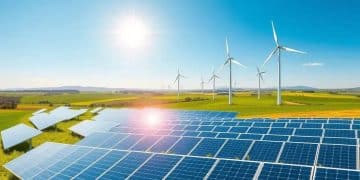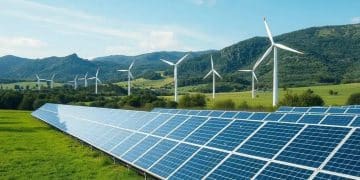Renewable energy incentives for homeowners explained

Renewable energy incentives for homeowners provide financial benefits such as tax credits and rebates, making it easier and more affordable to invest in systems like solar panels and wind turbines.
Renewable energy incentives for homeowners are more than just financial benefits; they represent a step towards a sustainable future. Have you thought about how these incentives could transform your energy bills? Let’s dive into the exciting possibilities!
Understanding renewable energy incentives
Understanding renewable energy incentives can greatly benefit homeowners looking to save on energy costs. These incentives are designed to encourage the adoption of renewable energy sources like solar and wind power. Homeowners often find themselves overwhelmed by the various options available, but it’s essential to grasp the basics to make informed choices.
What Are Renewable Energy Incentives?
Renewable energy incentives are programs and financial benefits provided by local, state, and federal governments. They aim to make it easier for homeowners to invest in clean energy solutions. The primary types of incentives include:
- Tax credits
- Rebates
- Grants
- Net metering programs
These incentives not only lower the initial investment cost but also improve the return on investment over time.
Benefits of Renewable Energy Incentives
Homeowners can experience numerous advantages by taking advantage of these incentives. For instance, tax credits significantly reduce the amount owed to the government, putting money back into your pocket. Rebates can lower the purchase price of renewable energy systems, making installations more affordable.
An exciting opportunity is net metering, where homeowners can sell excess energy generated back to the grid. This process not only helps you earn credits on your utility bill but also supports the community by contributing to the local energy supply.
Additionally, investing in renewable energy increases property values. Homes equipped with solar panels or wind turbines often attract more buyers, especially as eco-friendliness becomes a higher priority for many. As such, the presence of renewable energy systems can make your home stand out.
If you are considering switching to renewable energy, take the time to research the specific incentives available in your area. This knowledge will empower you to make choices that align with both your financial goals and environmental values.
Types of incentives available

Understanding the types of incentives available is key for homeowners interested in renewable energy. Various programs offer financial support to help offset the costs of installing renewable energy systems. Below are the main categories of incentives you should know about.
1. Federal Tax Credits
The federal government provides tax credits that allow homeowners to deduct a percentage of the installation costs from their taxable income. This significantly reduces the overall cost of your investment in renewable energy.
2. State and Local Rebates
Many states and local governments offer rebates to encourage the adoption of renewable energy. These rebates are often provided as cash back upon installation, further reducing your expenses.
- Available for solar systems.
- Applicable to energy-efficient upgrades.
- Programs vary by location.
To find available rebates, check with your state energy office or local utility company.
3. Grants and Low-Interest Loans
Grants are funds provided by governmental bodies that do not need to be repaid, making them an attractive option. Additionally, low-interest loans may be available to help cover the costs of purchasing renewable energy systems.
These financial options enable homeowners to afford changes that benefit both their wallets and the environment. The more knowledge you have about these types of incentives, the better equipped you are to maximize your savings.
Understand that these incentives can change, so it’s wise to stay updated on what’s available in your area. The combination of federal, state, and local programs can make a significant impact on the total investment required.
How to qualify for renewable energy programs
Knowing how to qualify for renewable energy programs is essential for homeowners looking to take advantage of available incentives. These programs often have specific criteria that must be met to receive benefits. Understanding these requirements can simplify the process.
1. Check Eligibility Requirements
Each program may have different eligibility criteria. Typically, these include:
- Homeownership status
- Type of renewable energy system
- Location of the property
- Income level limitations in some cases
Make sure to review these details early in your research to avoid wasting time.
2. Assess Your Property
Your property’s suitability for renewable energy systems can greatly influence your qualification. Factors such as roof orientation, size, and structural integrity play a role in determining if you can install solar panels or wind turbines. Consulting with a professional can help you evaluate your property.
Documentation such as your energy bills may be required to support your application. It is helpful to gather records ahead of time to streamline the process. Understanding your current energy usage can strengthen your case when applying for renewable energy programs.
3. Complete Program Applications
Most programs require a formal application process. This often involves filling out forms and providing the necessary documentation. Be thorough and precise when completing these forms.
Take care to provide any additional information requested by the approving body. This can include proof of income or quotes from contractors. Failing to include necessary information can delay or even deny your application.
4. Stay Updated on Program Changes
Renewable energy programs frequently change. Staying informed ensures you don’t miss out on new opportunities. Sign up for newsletters or follow local energy departments to keep up with current developments.
Keep track of deadlines for applications, as missing these can mean waiting for another cycle of funding or approval. By being proactive, you enhance your chances of qualifying successfully.
Maximizing savings with renewable energy investments

Maximizing savings with renewable energy investments is crucial for homeowners who want to reduce energy costs while being environmentally friendly. By making strategic choices, you can ensure you get the most value from your investment.
1. Choose the Right System
Every home has unique energy needs. Selecting the most suitable renewable energy system is the first step. Solar panels, for instance, work well for homes with ample sunlight. On the other hand, wind turbines may be ideal for properties with consistent wind patterns. Evaluate your location and energy usage to make the best choice.
2. Take Advantage of Incentives
As previously discussed, taking full advantage of available incentives can significantly lower your initial investment. Explore federal, state, and local rebates and tax credits. Applying for these programs not only reduces costs but can also enhance your financial return over time.
- Check for federal tax credits available for solar installations.
- Research local rebate programs that provide cash back.
- Consider enrolling in net metering to sell excess energy back to the grid.
These incentives can often cover a substantial portion of your installation costs, thereby increasing your savings.
3. Invest in Energy Efficiency
Improving your home’s energy efficiency is another critical aspect of maximizing savings. Before investing in renewable energy, ensure that your home is energy-efficient. Simple upgrades like better insulation and energy-efficient appliances can significantly reduce energy demand.
By lowering your overall consumption, you can maximize how much renewable energy systems can save you. For example, if your home operates efficiently, you will need fewer solar panels to meet your energy needs.
4. Monitor and Adjust Usage
Keeping track of your energy usage can help you make informed decisions. Use energy monitoring tools to identify peak usage times and adjust accordingly. If your system generates excess energy, find ways to utilize it effectively, such as during high-consumption periods.
Additionally, consider setting up smart home technology. Smart thermostats and energy monitors can provide insights and help optimize your energy consumption. The more efficiently you use your energy, the greater your savings.
\n
| 🌞 Choose Solar | Invest in solar panels for lower energy bills. |
| 💰 Use Incentives | Take advantage of tax credits and rebates. |
| 🏡 Improve Efficiency | Upgrade insulation and energy-saving appliances. |
| 📊 Monitor Usage | Track energy consumption to optimize savings. |
| 🌍 Go Green! | Make a positive impact on the environment. |
\n
\n
FAQ – Frequently Asked Questions about Renewable Energy Incentives for Homeowners
What are renewable energy incentives?
Renewable energy incentives are programs that provide financial benefits, like tax credits and rebates, to encourage the adoption of renewable energy systems.
How can I qualify for renewable energy programs?
To qualify, you typically need to meet specific eligibility criteria, such as property ownership and having the right type of renewable energy system installed.
What types of renewable energy systems are the best investments?
Solar panels and wind turbines are popular choices, but the best investment depends on your location and energy needs.
How can I maximize savings with renewable energy investments?
You can maximize savings by choosing the right system, taking advantage of incentives, improving your home’s energy efficiency, and monitoring your energy usage.





